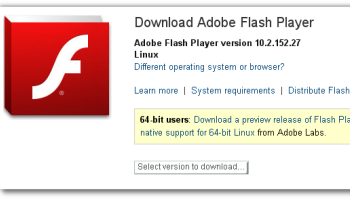Tales in Tech History: Adobe Flash

Adobe Flash: The story of a how a widely-used plugin transformed the web before security and usability concerns killed it off
Earlier this week Adobe made a long-expected announcement, when it said it would finally retire the much-maligned Flash platform at the end of 2020.
Over the years the Flash media player proved very popular, as it was widely used for advertisements, online games, video, and countless other web applications and educational tools.
But despite its immense popularity, Flash also had its critics, most notably Apple’s late co-founder Steve Jobs. To Jobs and others, Flash was nothing more than a CPU and battery hog, as well being as a serious security vulnerability.
 Drawing Program
Drawing Program
But for many years Flash was the dominant platform for online multimedia content, although it is now being abandoned in favour of HTML5.
But how did Flash begin? Well Flash been around for much longer than people may think. Its origins date back to the 1990s, when it started life as SmartSketch published by FutureWave Software.
SmartSketch was a drawing program for the PenPaint operating system (an OS designed for pen computers). When the PenPoint OS failed to take off, SmartSketch was ported to Windows and Mac OS.
In 1995 FutureWave tweaked SmartSketch by adding frame-by-frame animation features and released this new product as FutureSplash Animator on the PC and Macintosh.
Ironically, FutureWave had approached Adobe Systems (also in 1995) with the offer to sell them FutureSplash, but Adobe declined.
But others were not so reticent about the technology and they increasingly opted to use FutureSplash. This included Microsoft with MSN 2.0. Disney Online also used FutureSplash animations for its Daily Blast service.
FutureSplash was acquired by Macromedia in November 1996, and Macromedia then set about re-branding it and released FutureSplash Animator as Macromedia Flash 1.0.
Rising Star
It should be remembered that by now Flash was a two-part system, namely a graphics and animation editor (Macromedia Flash), and a player (Macromedia Flash Player).
Macromedia distributed its Flash Player as a free browser plug-in and it quickly gained significant market share thanks to its small size, making it ideal to download over the burgeoning Internet.
This tiny footprint endeared it to designers, who were really starting to discover just how versatile the program was becoming, and how it also allowed them to do dynamic things with websites, without using much bandwidth.
Indeed, when YouTube began life in 2005 and became popular, many websites also found that Flash was an easy way to encode videos that had been uploaded by users.
All of this helped drive the uptake of Flash, and in 2005 more computers worldwide had the Flash Player installed than any other Web media format, including Java, QuickTime, RealNetworks and Windows Media Player.
Adobe acquired Macromedia in 2005 for a cool $3.4bn (£2.6bn), a move that saw the entire Macromedia product line including Flash, Dreamweaver, Director/Shockwave, Fireworks and Authorware absorbed into the Adobe product stable.
Steve Jobs
Flash continued to grow and prosper then, but trouble was looming as despite its many updates over the years, Flash remained inherently insecure.
This was because the Flash player itself proved to be a nearly irresistible target for hackers and it provided numerous entry points for malware of all sorts. Worse, Flash updates were easily spoofed, tricking end users into installing fake updates that contained malware.
And Adobe’s Flash was also famously hated by the late Steve Jobs, after the former Apple CEO famously called it a doomed technology. Jobs also very publicly attacked Flash in April 2010, which prompted a bitter spat with Adobe’s then CEO.
In response Adobe even at one stage launched a smear advertising campaign that blasted Apple for its closed approach regarding developer licensing. But still Flash remained insecure and others began to lose patience with the technology.
In 2015 for example Mozilla blocked Adobe Flash by default following the discovery of yet more zero-day vulnerabilities in the browser plug-in. That block remained in place until Adobe rushed out a patch for the flaw but even Adobe had recognised that the days of Flash were numbered.
This was made clear in December 2015 when Adobe acknowledged the inevitability of an HTML5 world. Indeed, it said back then it was now “encouraging” developers and content creators away from Flash, in order to use newer web standards.
Conclusion
A clearer signal that Flash was on the way out could not be made, and in recent years, there has been a concerted drive away from Flash towards open web standards such as HTML5, WebGL and WebAssembly.
Numerous browsers, including Chrome and Firefox have now disabled Flash by default, and now less and less people are using the technology.
Google for example has pointed to data that showed that three years ago, 80 percent of Chrome desktop users visited at least one Flash-enabled site a day. However that figure was now less than 17 percent and it is still falling.
It has been quite a journey.
Flash began life as a drawing package for an obsolete operating system, and morphed into the defacto platform for online multimedia content. But its popularity was also its downfall, as was its inherent insecurity and resource sapping characteristics.
So RIP Adobe Flash, and thanks for the ride.
Quiz: What do you know about the cloud in 2017?